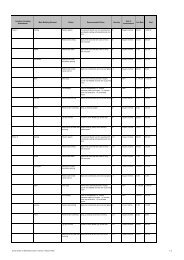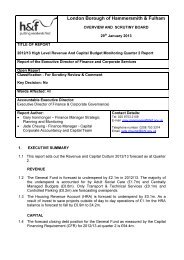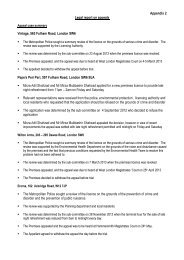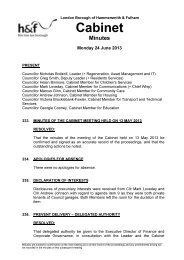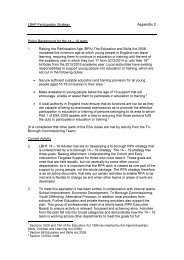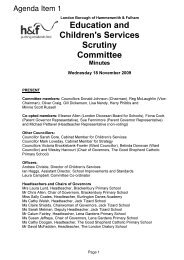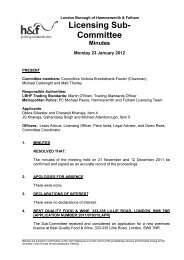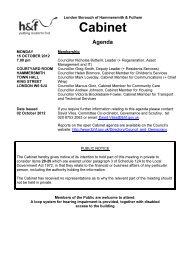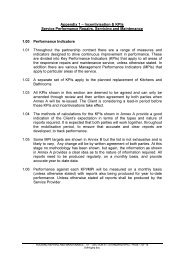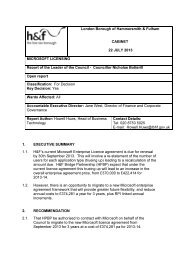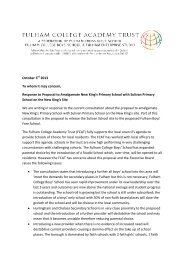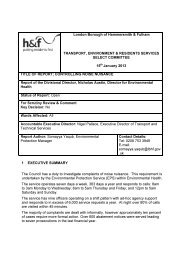Planning Applications PDF 1 MB - Meetings, agendas and minutes
Planning Applications PDF 1 MB - Meetings, agendas and minutes
Planning Applications PDF 1 MB - Meetings, agendas and minutes
You also want an ePaper? Increase the reach of your titles
YUMPU automatically turns print PDFs into web optimized ePapers that Google loves.
• Raised a number of queries relating to the remaining resident on site <strong>and</strong> the<br />
proposed tenure of any future scheme<br />
4.4 English Heritage raised no objections to the proposals.<br />
4.5 The Environment Agency raised no objections to the proposals.<br />
5.0 PLANNING ISSUES<br />
5.1 The main planning issues are considered to be demolition of a building within a<br />
conservation area; temporary loss of housing (including affordable housing); design<br />
(including public realm <strong>and</strong> trees); <strong>and</strong> flood Risk.<br />
Demolition of buildings within a conservation area<br />
5.2 The NPPF advocates a positive strategy for conserving <strong>and</strong> enhancing the historic<br />
environment, taking account of (amongst other things) the desirability of new<br />
development to make a positive contribution to local character <strong>and</strong> distinctiveness.<br />
Paragraph 137 of the NPPF says that Local Authorities should look for opportunities for<br />
new development within Conservation Areas to enhance or better reveal their<br />
significance.<br />
5.3 Paragraph 138 of the NPPF says that the loss of buildings which make a positive<br />
contribution to a conservation area should not be permitted. However, Paragraph 138<br />
also notes that not all elements will necessarily contribute to the conservation area.<br />
Furthermore, Paragraph 135 says that a balanced judgement will be required having<br />
regard to the scale of any harm or loss <strong>and</strong> the significance of a non-designated<br />
heritage asset.<br />
5.4 Paragraph 136 of the NPPF says that local planning authorities should not permit<br />
the loss of the whole or part of a heritage asset without taking all reasonable steps to<br />
ensure new development will proceed after the loss has occurred. In this regard,<br />
officers have considered the current contribution the buildings make to the conservation<br />
area as a `heritage asset' <strong>and</strong> the redevelopment programme that is in place to provide<br />
a replacement housing scheme. The l<strong>and</strong>scaping proposal, while planned as an interim<br />
measure, would nonetheless result in the removal of unsightly buildings <strong>and</strong> enhance<br />
the character <strong>and</strong> appearance of the conservation area.<br />
5.5 When considering development proposals in Conservation Areas, London Plan<br />
Policy 7.8 states that development affecting heritage assets <strong>and</strong> their settings should<br />
conserve their significance.<br />
5.6 Core Strategy Policy BE1 requires all new development to create a high quality<br />
urban environment that respects the surrounding setting, including heritage assets<br />
which protects <strong>and</strong> enhances conservation areas. Policy DM G7 of the Development<br />
Management Local Plan seeks to protect, restore or enhance the quality, character,<br />
appearance <strong>and</strong> setting of conservation areas.<br />
5.7 The S<strong>and</strong>s End Conservation Area Character Profile describes the special<br />
character of the S<strong>and</strong>s End Conservation Area, identifying buildings of note, historic<br />
facts <strong>and</strong> showing how the buildings, open spaces <strong>and</strong> streets work together to create<br />
an environment worthy of protection. The main feature within the conservation area,



